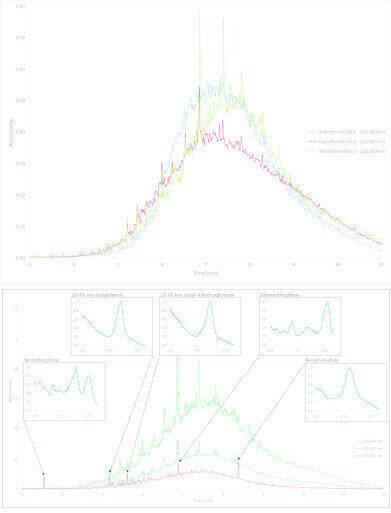-
 Figure 1. A GC-VUV chromatogram of typical transformer oil samples. Figure 2. A GC-VUV chromatogram of a typical transformer oil sample spiked with two hallmark oxidation inhibitors (2,6-di-tert-butylphenol and BHT) and three corrosive sulfurs (benzyl sulfide, benzothiophene, and dibenzothiophene). The selective use of spectral filters post-data acquisition mitigates matrix effects inherent to this analysis and allows the identification and quantitation of the compounds of interest.
Figure 1. A GC-VUV chromatogram of typical transformer oil samples. Figure 2. A GC-VUV chromatogram of a typical transformer oil sample spiked with two hallmark oxidation inhibitors (2,6-di-tert-butylphenol and BHT) and three corrosive sulfurs (benzyl sulfide, benzothiophene, and dibenzothiophene). The selective use of spectral filters post-data acquisition mitigates matrix effects inherent to this analysis and allows the identification and quantitation of the compounds of interest.
Analytical Instrumentation
GC-VUV Provides New Analytical Tool for DHA and Transformer Oil Compound Characterisation
Apr 28 2017
With the approval of ASTM Method D8071 for PIONA compound analysis and initiation of its corresponding ILS study, VUV Analytics, Inc. (Austin, TX) has begun exploring new applications of VUV spectroscopy in fuels refining. Dr. Phillip Walsh and collaborators Tom Grills and John J. Grills III of Envantage, Inc. are exploring the hyphenation of Vacuum Ultraviolet (VUV) Spectroscopy detection with detailed hydrocarbon analysis (DHA). Preliminary results have shown that the combination of technologies enhances the accuracy and robustness of production DHA measurements. The VUV Analytics Applications team also recently completed a study showing how key components in transformer oil can be characterized despite complex matrices that are difficult to resolve by standard GC methods.
VUV-DHA method provides a means of compound verification via VUV spectral matching, as well as the ability to resolve co-elution that exists in a typical DHA separation. This deconvolution capability reduces the complexity of DHA methods by removing the need for a tuned pre-column or sub-ambient start temperature. The spectral matching drastically reduces the need for stringent retention time control. Based on preliminary conclusions the investigative team believes that the combination will result in better reliability, more automation with less calibration, and higher throughput when compared to traditional DHA.
The VUV Analytics Applications team concluded a study in early April showing how oxidation inhibitors and corrosive compounds within transformer oils can be identified and quantitated despite their unresolved complex matrices (UCMs). GC methods typically have difficulty accurately characterizing samples such as those shown in the GC-VUV chromatogram of Figure 1. Two compound classes known to be of interest to those analyzing transformer oil are oxidation inhibitors and corrosive sulfurs. Inhibitors are monitored so that their percent by weight does not drop below 0.1%, and their concentrations vary from ppb to tens of ppm. Disulfides and thiophenes are among the more stable corrosive sulfur compounds found in transformer oil and thus present an obvious target for monitoring. Benzothiophenes are especially prevalent in these types of samples.
Oxidation inhibitors (2,6-di-tert-butylphenol and BHT) and three corrosive sulfurs (benzyl sulfide, benzothiophene, and dibenzothiophene) were spiked with 50 ng/µL in a 1:10 dilution of representative transformer oil. The sample was run using an Rxi-1ms 15m x 0.25mm x 0.25µm df column and injected at 275°C, split 10:1, with a 1 µL injection volume. Figure 2 shows a GC-VUV chromatogram with different spectral filters applied post-data acquisition for selective analyte visualization. Aromatic compounds absorb strongly between 170 – 200 nm, and the spiked analytes are distinct when this filter is used. This approach allowed a linearity study of these compounds in transformer oil to be performed across a concentration range of 5 – 2000 ng/µL. All of the oxidation inhibitor and corrosive sulfur analytes spiked into transformer oil showed linearity of 0.995 or better across 3 orders of magnitude. This novel application of GC-VUV to the characterization of transformer oil analytes suggests a new, more straightforward method for monitoring critical compounds that are difficult to analyze by other GC-based methods.
For more detailed information please visit our website at www.vuvanalytics.com, or contact us at info@vuvanalytics.com.
Digital Edition
PIN 25.1 Feb/March
March 2024
In This Edition Safety - The technology behind the ION Science Tiger XT - Safety with ammonia and LOHCs as hydrogen carriers Analytical Instrumentation - Discussion on new tribology te...
View all digital editions
Events
Apr 22 2024 Hannover, Germany
Apr 22 2024 Marrakech, Morroco
Apr 22 2024 Muscat, Oman
Apr 22 2024 Rotterdam, Netherlands
Apr 23 2024 Singapore

















